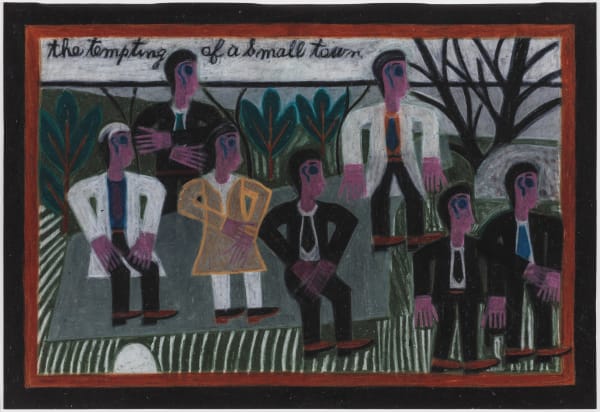Eddie Arning (1898-1993): Under The Influence
Eddie Arning was born in 1898 in Germania, Texas to one of the German homesteading families that had settled there 15 years earlier. Arning was a troubled youth, ultimately diagnosed with what would now be called schizophrenia; he was committed to a state hospital when he was 30 years old but returned home after a year. In 1934, after some violent behavior, he was again institutionalized. Fast forward 30 years: an occupational therapist at the hospital asylum gave Arning some art materials—paper and crayons—as well as some encouragement, and he began creating art.
At first, Arning largely drew singular images of objects remembered from his farm youth. After several years he was given oil pastels (Cray-Pas), which expanded his color range. At the same time he turned to magazine illustrations as his major source of visual inspiration, often preserving portions of their compositions while re-imagining and reconfiguring their elements. Arning’s work became larger and more complex in all regards and he expanded the singular characteristics that define his art: bold colors, profiled humans, and tightly-wrought designs with multiple borders. Every work in “Under the Influence” is accompanied by the magazine illustration that was its inspiration. All the paintings date from a time near the end of Arning’s career when he had fully mastered his medium and have not been seen since they were purchased.
Almost the entirety of Arning’s oeuvre was created in the 10 years between 1964 and 1974, when his behavior caused his expulsion from the institution where his career had started. He then went to live with his sister and his creative work ended. Arning died in 1993. Alexander Sackton, a professor in the English department of the University of Texas at Austin, first brought Arning’s work to public attention, cataloging and selling a number of paintings from his home to help pay the artist’s expenses. Arning’s first public exhibition was in 1965: 40 paintings hung at the Dupree Gallery in Irving, Texas—a non-commercial exhibition space. Eight paintings from that exhibition were included in the first public offering of his work in 1975 at the Delahunty Gallery in Dallas. I purchased all 10 paintings presented in that show and a large portion of Arning’s second show the next year. I’ve held these works—some of Arning’s first works chosen for public presentation and sale, important both historically and aesthetically—until now.
Since its debut, Arning’s work has been the subject of a number of exhibitions, including a one-person year-long show at the Abby Aldrich Rockefeller Folk Art Center in Williamsburg, Virginia (1985)—one of the many institutions that own his work. Others are the Museum of Fine Arts in Boston, the Minneapolis Institute of Art, the Smithsonian American Art Museum in Washington D.C., and the American Folk Art Museum in New York. Illustrations of Arning’s paintings and articles about his life and work have appeared in many books, catalogs, and magazines.
-Jonathan Holstein















